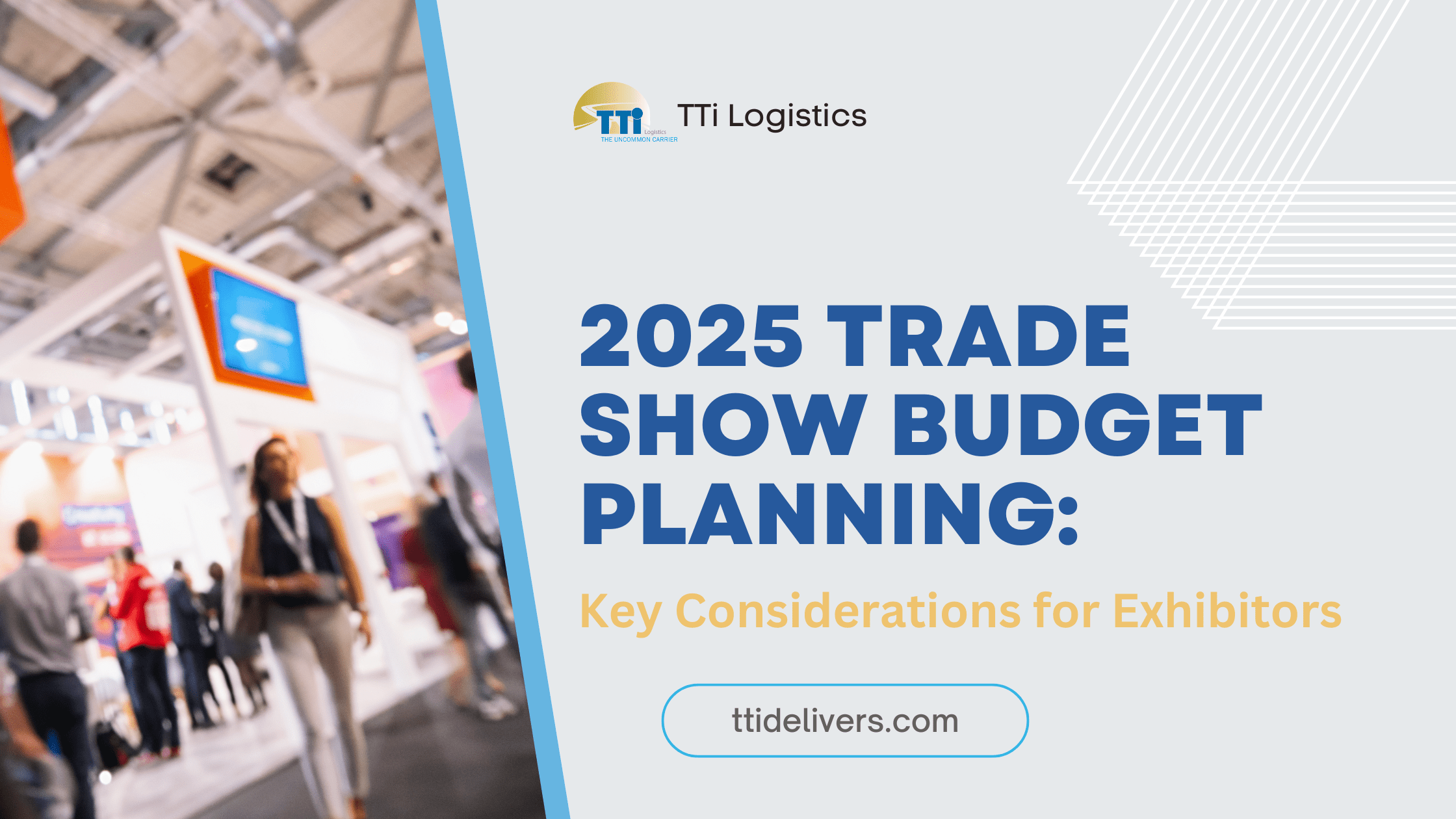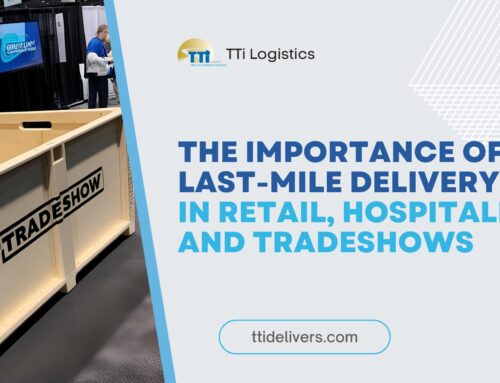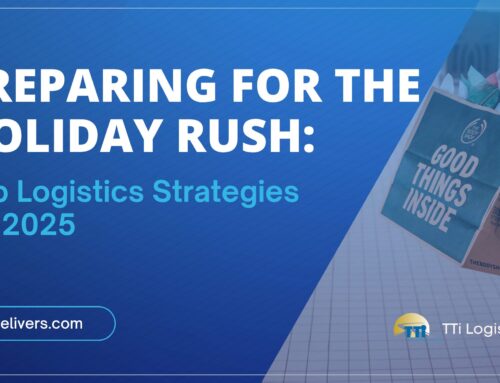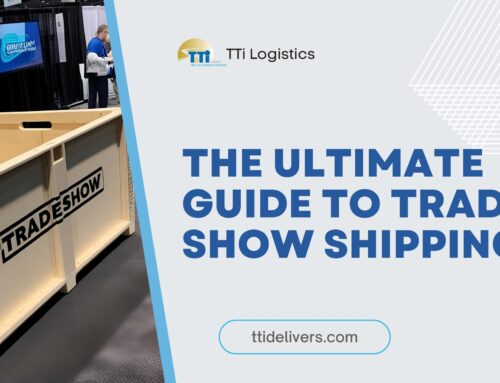Key Considerations for Budgeting Your 2025 Trade Show
Planning for a trade show is a significant undertaking, and budgeting for trade shows is one of the most critical aspects of this process. A well-planned budget ensures that you maximize your investment and avoid unexpected costs, enabling you to focus on building connections and showcasing your business. As we look ahead to 2025, trade show budgeting strategies are evolving, with new considerations and opportunities for cost savings and efficiency.
In this blog, we’ll explore the key considerations for exhibitors when budgeting for a trade show in 2025, from pre-show planning to post-event follow-up. With over 25 years of experience in the trade show shipping industry, TTi Logistics has become the go-to partner for exhibitors, offering reliable solutions to streamline the entire process. Whether you’re a seasoned exhibitor or attending your first show, these insights will help ensure your trade show budget is well-structured and strategically allocated.
1. Pre-Show Planning: Creating a Comprehensive Budget
When it comes to budgeting for a trade show, the planning phase is where you lay the foundation for success. Start by establishing clear goals for your event, which will help guide your budgeting decisions. Are you aiming to generate leads, build brand awareness, or launch a new product? Knowing your goals will help you allocate your resources effectively.
Your trade show budget should include the following key categories:
- Booth Space and Design: Trade show booth costs can vary widely based on the size of the space, the show’s location, and the complexity of your booth’s design. For 2025, expect rental fees to continue rising as demand for premium spaces increases. Plan for booth design and materials, including backdrops, lighting, furniture, and technology.
- Travel and Accommodation: Exhibiting at a trade show often requires traveling to a different city or country. Factor in the costs of flights, hotels, meals, and transportation for your team. Booking early can often result in savings, especially if you take advantage of group rates or loyalty programs.
- Shipping and Logistics: One of the most overlooked aspects of budgeting for a trade show is the cost of shipping your materials to the event. This includes your booth setup, marketing materials, and any products you plan to display. Partnering with a reliable logistics provider like TTi Logistics ensures smooth transportation of your materials, avoiding costly delays and damage.
- Marketing and Promotion: To maximize your trade show presence, you’ll need to invest in marketing efforts before, during, and after the event. This includes digital campaigns, printed collateral, giveaways, and promotional items. Set aside a portion of your budget for these efforts to increase foot traffic to your booth and engage with potential leads.
2. Choosing the Right Trade Show
Not every trade show is the right fit for your business. In 2025, selecting the most relevant events will be key to optimizing your budget. Research shows to align with your industry, target audience, and goals. You should also consider the location and timing of the event, as these factors can significantly impact costs.
For example, if your primary goal is to connect with buyers from a specific region, choose a trade show located in that area to reduce travel and shipping expenses. Similarly, attending a trade show that coincides with other events in your industry may increase your networking opportunities and reduce costs through shared logistics.
3. Leveraging Technology for Cost Savings
As technology continues to advance, there are more opportunities for cost savings in trade show budgeting. For 2025, consider how you can use technology to enhance your booth while minimizing expenses.
- Virtual Booth Components: While traditional booth setups can be expensive to transport and assemble, virtual booth elements can offer a cost-effective alternative. Using digital displays, augmented reality (AR), or interactive kiosks can reduce the need for large physical structures while engaging attendees in a more dynamic way.
- Lead Capture and CRM Integration: Invest in technology that streamlines lead capture and integrates with your CRM system. This reduces the need for manual entry and follow-up after the event, saving both time and money. Many trade show platforms offer affordable solutions that automate the lead-tracking process.
- Hybrid Events: Hybrid events, which combine in-person and virtual attendance, are expected to continue in 2025. By offering virtual components, you can reduce travel costs for some team members while still engaging with attendees remotely. This approach also allows you to expand your reach beyond the physical event.
4. Managing On-Site Costs
Once you’ve accounted for the big-ticket items, it’s important to factor in the on-site costs that can quickly add up during the event. These include expenses like labor for booth setup and teardown, Wi-Fi, electricity, and daily meals for your team. Make sure these costs are included in your trade show budget to avoid surprises.
Consider ways to reduce on-site costs:
- Shared Booth Staff: If you’re attending a trade show with partners or industry peers, consider sharing booth space or staff to reduce labor costs.
- Pre-Paid Services: Many trade shows offer discounted rates if you book services like internet access or booth cleaning in advance. Take advantage of these pre-show deals to reduce your overall spending.
5. Post-Event Budget Considerations
Your budgeting for a trade show shouldn’t stop when the event ends. There are important post-event activities that need funding, including lead follow-up, data analysis, and shipping materials back to your office or warehouse.
- Lead Follow-Up: Allocate a portion of your budget for post-show marketing campaigns that nurture the leads you’ve captured. This could include email campaigns, phone calls, or personalized outreach. The quicker you can follow up, the better your chances of converting leads into customers.
- Booth Storage and Maintenance: If you plan to use your booth at multiple trade shows in 2025, consider the costs of storing it between events. TTi Logistics offers warehousing solutions to store your booth and materials safely, preventing damage and reducing transportation costs.
- Evaluating ROI: After the event, take the time to evaluate your return on investment (ROI) from the trade show. Review your budget to see if you stayed on target and assess which areas delivered the best value. This will help you refine your trade show budgeting strategy for future events.
Preparing for a Successful 2025 Trade Show: Final Thoughts
Budgeting for trade shows in 2025 requires careful planning and strategic thinking. By considering all aspects of the event—from booth space and travel to post-show follow-up—you can create a comprehensive budget that ensures you get the most value from your investment. Partnering with a reliable logistics provider like TTi Logistics can help streamline your shipping and storage needs, giving you peace of mind and reducing unexpected costs.
With the right budgeting strategies in place, you’ll be well-prepared to make a strong impact at trade shows in 2025 and beyond.







